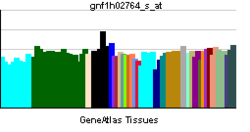Sp7 transcription factor
| SP7 | ||||||
|---|---|---|---|---|---|---|
| Identifiers | ||||||
| Aliases | SP7, OI11, OI12, OSX, osterix, Sp7 transcription factor | |||||
| External IDs | MGI: 2153568 HomoloGene: 15607 GeneCards: SP7 | |||||
| RNA expression pattern | ||||||
 | ||||||
| More reference expression data | ||||||
| Orthologs | ||||||
| Species | Human | Mouse | ||||
| Entrez | ||||||
| Ensembl | ||||||
| UniProt | ||||||
| RefSeq (mRNA) | ||||||
| RefSeq (protein) | ||||||
| Location (UCSC) | Chr 12: 53.33 – 53.35 Mb | Chr 15: 102.36 – 102.37 Mb | ||||
| PubMed search | [1] | [2] | ||||
| Wikidata | ||||||
| View/Edit Human | View/Edit Mouse |
Transcription factor Sp7 is a protein that in humans is encoded by the SP7 gene.[3][4]
SP7 is a C2H2-type zinc finger transcription factor of the SP gene family and a putative master regulator of osteoblast differentiation (Gao et al., 2004).[supplied by OMIM][4]
References
- ↑ "Human PubMed Reference:".
- ↑ "Mouse PubMed Reference:".
- ↑ Nakashima K, Zhou X, Kunkel G, Zhang Z, Deng JM, Behringer RR, de Crombrugghe B (Jan 2002). "The novel zinc finger-containing transcription factor osterix is required for osteoblast differentiation and bone formation". Cell. 108 (1): 17–29. doi:10.1016/S0092-8674(01)00622-5. PMID 11792318.
- 1 2 "Entrez Gene: SP7 Sp7 transcription factor".
Further reading
- Strausberg RL, Feingold EA, Grouse LH, et al. (2003). "Generation and initial analysis of more than 15,000 full-length human and mouse cDNA sequences.". Proc. Natl. Acad. Sci. U.S.A. 99 (26): 16899–903. doi:10.1073/pnas.242603899. PMC 139241
 . PMID 12477932.
. PMID 12477932. - Gronthos S, Chen S, Wang CY, et al. (2003). "Telomerase accelerates osteogenesis of bone marrow stromal stem cells by upregulation of CBFA1, osterix, and osteocalcin.". J. Bone Miner. Res. 18 (4): 716–22. doi:10.1359/jbmr.2003.18.4.716. PMID 12674332.
- Milona MA, Gough JE, Edgar AJ (2004). "Expression of alternatively spliced isoforms of human Sp7 in osteoblast-like cells.". BMC Genomics. 4 (1): 43. doi:10.1186/1471-2164-4-43. PMC 280673
 . PMID 14604442.
. PMID 14604442. - Gao Y, Jheon A, Nourkeyhani H, et al. (2005). "Molecular cloning, structure, expression, and chromosomal localization of the human Osterix (SP7) gene.". Gene. 341: 101–10. doi:10.1016/j.gene.2004.05.026. PMID 15474293.
- Gerhard DS, Wagner L, Feingold EA, et al. (2004). "The status, quality, and expansion of the NIH full-length cDNA project: the Mammalian Gene Collection (MGC).". Genome Res. 14 (10B): 2121–7. doi:10.1101/gr.2596504. PMC 528928
 . PMID 15489334.
. PMID 15489334. - Morsczeck C (2006). "Gene expression of runx2, Osterix, c-fos, DLX-3, DLX-5, and MSX-2 in dental follicle cells during osteogenic differentiation in vitro.". Calcif. Tissue Int. 78 (2): 98–102. doi:10.1007/s00223-005-0146-0. PMID 16467978.
- Wu L, Wu Y, Lin Y, et al. (2007). "Osteogenic differentiation of adipose derived stem cells promoted by overexpression of osterix.". Mol. Cell. Biochem. 301 (1-2): 83–92. doi:10.1007/s11010-006-9399-9. PMID 17206379.
- Amorim BR, Okamura H, Yoshida K, et al. (2007). "The transcriptional factor Osterix directly interacts with RNA helicase A.". Biochem. Biophys. Res. Commun. 355 (2): 347–51. doi:10.1016/j.bbrc.2007.01.150. PMID 17303075.
- Fan D, Chen Z, Wang D, et al. (2007). "Osterix is a key target for mechanical signals in human thoracic ligament flavum cells.". J. Cell. Physiol. 211 (3): 577–84. doi:10.1002/jcp.21016. PMID 17311298.
- Zheng L, Iohara K, Ishikawa M, et al. (2007). "Runx3 negatively regulates Osterix expression in dental pulp cells.". Biochem. J. 405 (1): 69–75. doi:10.1042/BJ20070104. PMC 1925241
 . PMID 17352693.
. PMID 17352693.
External links
- Sp12 Transcription Factor at the US National Library of Medicine Medical Subject Headings (MeSH)
This article is issued from Wikipedia - version of the 6/5/2016. The text is available under the Creative Commons Attribution/Share Alike but additional terms may apply for the media files.